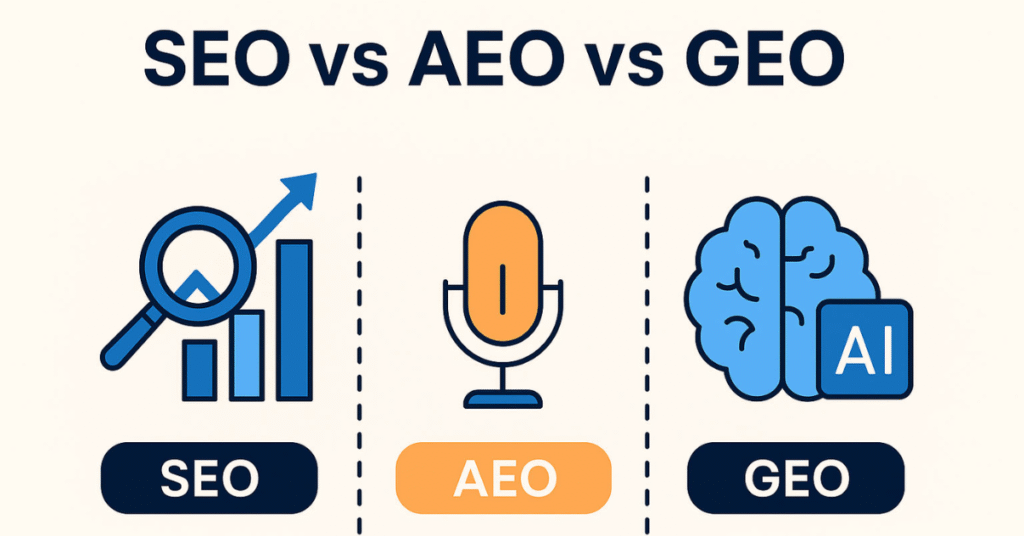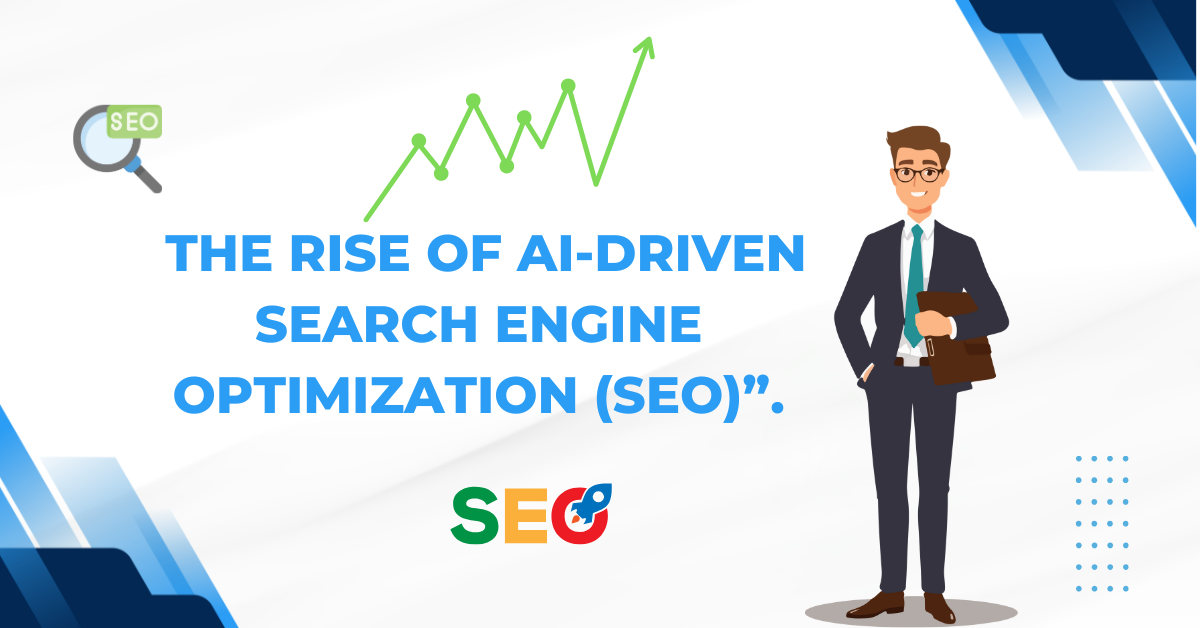Search engines are evolving faster than ever. With AI-powered models like Google Gemini, ChatGPT Search, and Perplexity, the digital landscape has shifted from keyword-based SEO to intent-based optimization.
If you’re still relying only on traditional SEO, you’re already behind.
In this article, we’ll explore how AI-driven SEO, AEO (Answer Engine Optimization), and GEO (Generative Engine Optimization) are transforming the future of digital visibility — and how you can adapt your strategy to dominate search results in 2025 and beyond.

Understanding the Evolution of SEO
What is SEO (Search Engine Optimization)?
SEO is the process of optimizing your website to rank higher on search engine result pages (SERPs) like Google.
It focuses on:
- Keyword research & placement
- On-page and technical optimization
- Backlink building
- User experience and engagement
Goal: Help search engines understand your content and match it to user queries.
Example:
If someone searches “best solar panels in India 2025,” Google ranks websites that have relevant, high-quality, and optimized content matching that intent.
Why Traditional SEO Isn’t Enough Anymore
Old SEO focused on:
- Stuffing keywords into blogs
- Building backlinks from any site
- Chasing algorithm loopholes
But today’s algorithms use AI, natural language processing (NLP), and semantic understanding. They analyze intent, context, and user satisfaction — not just keywords.
In short: SEO has evolved from “keyword matching” to “intent understanding.”
AEO — The Rise of Answer Engine Optimization
What is AEO?
AEO (Answer Engine Optimization) focuses on optimizing content for AI-powered answer engines like:
- Google’s Featured Snippets
- ChatGPT Search
- Perplexity AI
- Bing Copilot
These engines don’t just display links — they deliver direct answers.
To get visibility, you need to create content that AI can easily read, summarize, and trust.
Key AEO Strategies
- Write concise, factual summaries at the top of your articles.
- Use FAQ-style headings (H2/H3) — “What is…”, “How does…”, “Why is…”
- Provide structured data (schema markup) for better AI readability.
- Optimize for E-E-A-T (Experience, Expertise, Authority, Trustworthiness).
Example:
When users ask ChatGPT: “What is AEO?”
If your blog has a clear, short definition in a schema-supported paragraph, AI can cite and summarize your content directly.
GEO — Generative Engine Optimization (The Future)
What is GEO?
GEO (Generative Engine Optimization) is the next phase of SEO — optimizing for AI chatbots and generative search models that synthesize answers, not just link results.
Examples:
- ChatGPT, Gemini, Perplexity, and Bing Copilot use generative AI to create summarized responses from multiple sources.
How GEO Works:
- AI scans multiple websites.
- It extracts contextually relevant, trusted, and semantically clear information.
- It generates human-like responses, crediting top sources.
GEO Optimization Tips:
- Write with conversational, human-like flow.
- Include unique perspectives or data (AI loves originality).
- Use clear formatting — bullets, headings, tables, and summaries.
- Ensure your author bios and domain authority are verified.
Pro Tip: AI engines favor websites that demonstrate real expertise and human insight, not generic AI-written fluff.
SEO vs AEO vs GEO — The Core Differences
| Feature | SEO (Traditional) | AEO (Answer Engine) | GEO (Generative Engine) |
|---|---|---|---|
| Focus | Keywords & ranking | Direct answers | AI-generated context |
| Platform | Google SERPs | Snippets, voice search | Chatbots, AI search |
| Goal | Rank higher | Appear in answers | Be referenced in AI outputs |
| Content Style | Keyword-optimized | Question-answer format | Conversational, insightful |
| Tools Used | Ahrefs, SEMrush | Schema, FAQs | NLP analyzers, semantic tools |
| Metrics | CTR, backlinks | Snippet visibility | Citation frequency in AI |

How to Optimize for All Three (SEO + AEO + GEO)
Step 1: Do Deep Keyword + Intent Research
Use:
- Ahrefs / SEMrush / Ubersuggest → Find low-competition, long-tail keywords
- Google’s “People Also Ask” → Discover AEO-style queries
- ChatGPT + Perplexity → Identify conversational intent keywords
💬 Example:
Keyword: “AI tools for digital marketing in India”
Intent: Informational (educate)
Long-tail version: “How AI tools are transforming small business marketing in India (2025)”
Step 2: Structure Content for Multi-Engine Visibility
Use this SEO-AEO-GEO hybrid format:
- H1: Core title with keyword
- Intro paragraph: Explain topic simply and hook reader
- H2/H3: Use questions + FAQs (AEO friendly)
- Bullets, tables, infographics: For readability
- Conclusion: Summary + CTA
Step 3: On-Page SEO Best Practices
Use your primary keyword in:
- Title (H1)
- Meta description (within first 150 characters)
- First paragraph
- One subheading (H2)
Add:
- Internal links (related articles)
- External links (authority sources)
- Alt text for images
- Fast-loading, mobile-optimized design
Step 4: AI-Enhanced Technical SEO
Use tools like:
- Google Search Console → Indexing
- PageSpeed Insights → Speed optimization
- Schema.org markup → AI readability
- SSL & Core Web Vitals → Ranking trust factor
Step 5: Build Backlinks & Authority
Smart Link Building Ideas:
- Guest posts on niche sites
- HARO (Help A Reporter Out) submissions
- LinkedIn content collaborations
- Broken link outreach
Internal Linking Strategy:
Connect every new blog to 3–5 relevant old ones to boost topical authority.
Step 6: Promote & Repurpose Your Content
Share on:
- LinkedIn, Twitter (X), Instagram Reels
- Email newsletters
- YouTube summaries
- Quora & Reddit threads
📹 Repurpose blogs into short videos or carousels to capture more audience touchpoints.
Step 7: Track, Update & Improve
Use:
- Google Analytics 4 for traffic insights
- Ahrefs / RankMath / SurferSEO for keyword performance
- Update every 60–90 days with new stats and trends
Pro Tips & Bonus Hacks
Use semantic keywords (related terms, not exact matches).
Add AI detectors + human edit to ensure natural flow.
Publish at least 2 blogs per week to build topical authority.
Include visual content — infographics, tables, and videos.
Always include a clear CTA (“Contact Digify Pro for AI-driven SEO solutions!”).
What is the difference between SEO, AEO, and GEO?
Why is traditional SEO no longer enough in 2025?
Why is traditional SEO no longer enough in 2025?
How does AI impact SEO and digital marketing?
Final Thoughts
The future of SEO is AI + intent + authority.
By understanding the difference between SEO, AEO, and GEO, you’ll stay ahead of the curve and make your content visible not only on Google — but across AI search ecosystems.
💬 Ready to dominate AI-driven search?
👉 Contact Digify Pro for next-gen digital marketing & SEO strategies that deliver real results.



